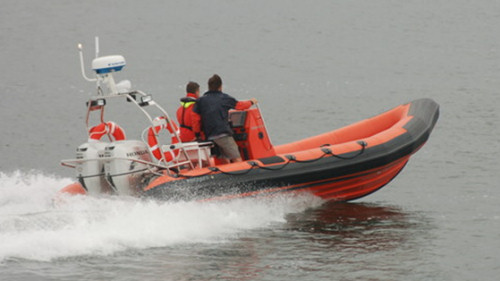Access More Boat Tests
Already have an account? Login
RIBCRAFT 6.5 (2011-)
Price
See the price by becoming
a BoatTEST member.
Members Must Log In
Brief Summary
For versatility, no boat beats a rigid inflatable. And when it comes to RIBs, RIBCRAFT is one of the type's leading names. Its 21'5" (6.5 m) model 6.5 is a good example: It can be spec'd in countless ways -- as a yacht tender, sportboat, dive boat, duck hunting, fishing boat, beach boat, as a launch – you name it. Builder of rigid inflatable boats for the military, fire and police departments and commercial marine clients worldwide, RIBCRAFT will build you a rigid inflatable boat just about any way you want it. Even if you plan to use your 6.5 for pure pleasure, it'll be constructed using the same materials and techniques that RIBCRAFT employs for its most demanding clients (read: special ops). You can even get it with an aluminum hull, excellent for navigating treacherous waters, or beaching on rocky shores for exploring or picnicking -- or just plain saving weight. No maritime adventurer would leave home without a multitool and a Swiss Army knife, and most rely on RIBs, too.
Specifications
| Length Overall | 21' 5'' / 6.5 m |
|---|---|
| Beam |
8' 5'' 2.57 m |
| Dry Weight |
1,365 lbs. |
| Draft |
16'' 0.41 m |
| Deadrise/Transom | 25 deg. |
| Max Headroom | open |
| Bridge Clearance | N/A |
| Fuel Capacity |
60 gal. 227 L |
| Water Capacity | none |
Engine Options
| Tested Engine |
Currently no test numbers |
|---|---|
| Std. Power |
Not Available |
| Opt. Power |
Not Available |
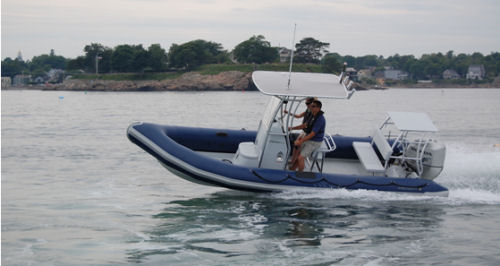
Have It Your Way
Because they build for a wide range of clients who use their boats for everything from firefighting to offshore rescue to Special Ops missions, RIBCRAFT has on hand a wide variety of options applicable to pleasure use as well. If you don't want the center-console and leaning post arrangement, for example, you can specify a pair of pod seats that you ride like a motorcycle saddle, but with backrests. (To us, they look ideal for rough-water work, more secure than standing.) If you're a loner, you can get just one pod – if gregarious, you can fill the cockpit with them. Or you can have a bench seat at the helm. The 6.5 is truly a "have it your way" boat.
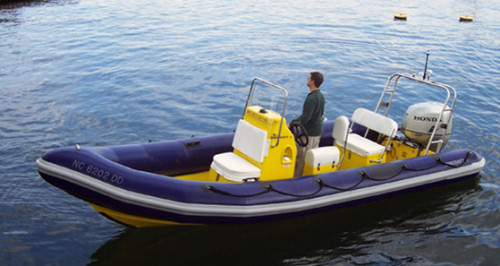
Construction
RIBs are two-part vessels – the rigid part is built like a conventional hull, while the inflatable part is built of fabric and air. In the RIBCRAFT 6.5, both parts are built tough enough for commercial, military or lifesaving work as well as pleasure boating. The "recreational" model differs from, say, the law-enforcement model only in its options. Both boats are built just the same.
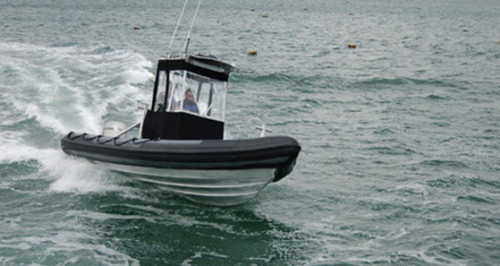
Ribcraft builds both the rigid and inflatable components in its own factories. Most hulls are solid fiberglass supported by composite stringers; there is no wood anywhere in the boat. An internal hull liner and a deck mold complete the rigid package; the liner includes a compartment for the aluminum fuel tank. All the components are bonded together with a methacrylate adhesive. However, marine-grade aluminum hulls are optional.
Ribcraft tubes are Hypalon on the outside, neoprene on the inside (two layers of each), reinforced with a polyester mesh in between. Hypalon is the "rubber" used in most quality inflatable boats today – it has high strength and is very UV-resistant. It's not uncommon for Hypalon inflatables to last up to 30 years, even under tropical sun.
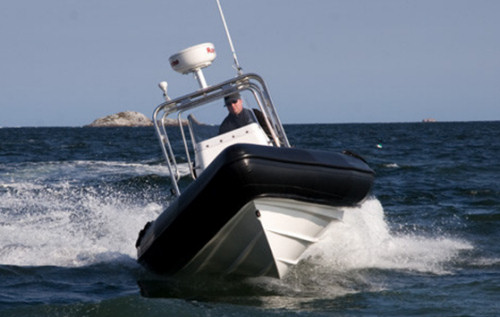
The tube on the 6.5 is one continuous unit comprised of five air chambers, each one protected by a pressure relief valve to reduce the chance of puncture in the event of collision or other misadventure. The relief valves can also trip on hot afternoons if the tube has been topped-up on a cool morning. Pressure in a properly inflated tube is about 2.7 psi; it's adjusted by feel, not by gauge – pump it up until it's hard, "like a soccer ball," said a RIBCRAFT representative.
The tube is attached to the hull with adhesive, via a fabric "hinge" glued atop a flange molded into the hull. The hinge lets the tube flex as the boat runs through a chop. The tube is also connected to the bottom of the flange and at the transom, with 20 further reinforcement patches around the hull. There are no mechanical fastenings.
RIB Advantages...
RIBs, whether built by RIBCRAFT or another manufacturer, make good recreational boats because they are lightweight on a length-for-length basis – their hull sides are mostly air. Their tubes provide lots of stability, so the rigid hull can be narrow and deep for rough-water capability; the light weight and narrow hulls working together make them faster than conventional boats for a given horsepower.
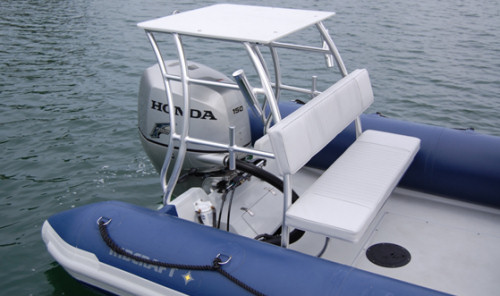
... And Disadvantages
The tubes mean less space in the cockpit compared to conventional boats. While the RIBCRAFT 6.5 is 21' 5" LOA (6.5 m), its interior length is 16' 4" (4.98 m), thanks to the length taken up by the 20"-diameter (.5 m) tube. Similarly, the 8' 5" (2.57 m) beam overall is reduced to 5' 6" (1.68 m) in the cockpit. If interior area is critical for you, maybe it's smarter to use interior rather than exterior dimensions for comparison shopping, or at least be aware of this RIB characteristic.
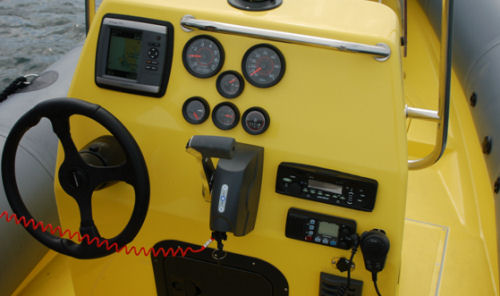
The narrower beam means the console has to be narrower, too, so there's no chance of fitting a Porta-Potti inside, as is possible on some center consoles this size. The tubes also do away with under-gunwale stowage; RIBCRAFT offsets this with stowage inside the pod seats and under the bench seats and foredeck. But long items -- boat hooks, paddles and deck brushes – might have to be left ashore. (On the other hand, one need not carry fenders, since they're built into the boat.). Does that really matter? Not to us – we love RIBs despite their shortcomings, and are very partial to those built go-anywhere tough like the RIBCRAFT 6.5.
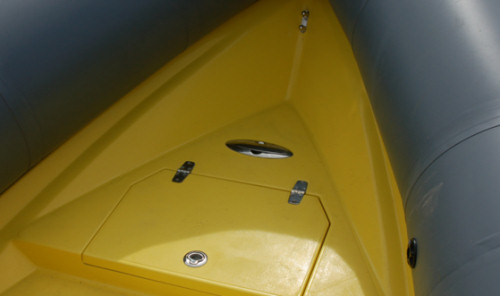
Propulsion
The RIBCRAFT 6.5 is light, so a single outboard should be plenty of power; a company rep we spoke with said the 6.5 typically carries a 150-hp engine. That will produce top speed between 41 and 44 knots, he said. We haven't tested the boat yet, so call RIBCRAFT, not us, if your 6.5 doesn't match those figures. Maximum rated horsepower is 175.
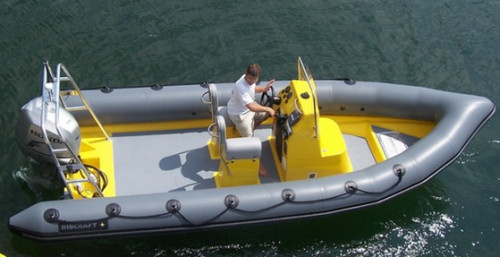
The 60-gallon (227 L) gas tank lives under a removable deck panel, making inspection and removal of the tank straightforward. What a concept! Too many builders make their tanks inaccessible, except with a chop saw. The fuel fill is on the console.
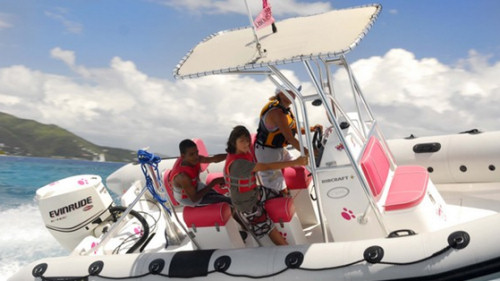
Recommendations
Only you know if you want a RIB, or would do better with a conventional boat. We won't presume to tell you, but if you are a RIB person, the RIBCRAFT 6.5 is a good choice. It's ruggedly built, can be set up almost any way you want, should be excellent in nasty weather and can carry a load of people or gear. It's just the boat you need for memorable adventures on the water. There are so many options we can't give you exact prices, but most 6.5s run between $55,000 and $65,000, depending on power and how crazy you go with options. Our contact at RIBCRAFT said it's possible to spend $70,000 on a 6.5 if you really load it up. We think you should give this boat a look before you buy any RIB.
